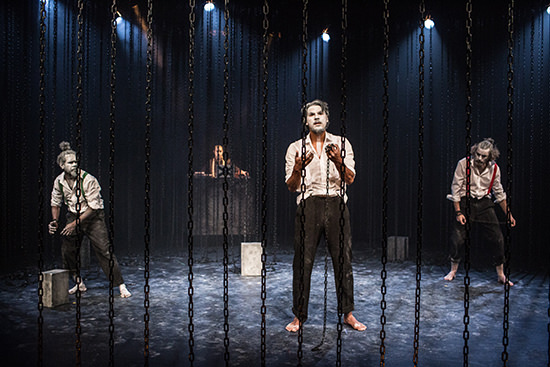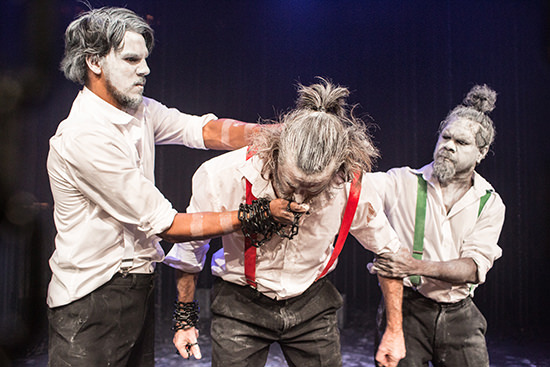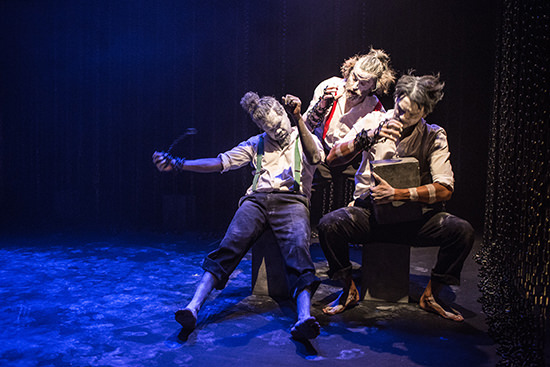Laughter & pain in a post-colonial limbo
Jonathan W Marshall: Yirra Yaakin, So Long Suckers

So Long Suckers, Yirra Yaakin Theatre Company
In Yirra Yaakin’s So Long Suckers—cheekily promoted as “Bangarra meets Beckett”—three ochre-faced men (Ian Wilkes, Emmanuel James Brown, Peter Docker), each bearing in stately fashion a tombstone-like box, enter a black corner stage draped with a veil of dangling chains. The ensuing action mirrors Beckett’s dramatisations of the self-conscious discourse of characters imprisoned within an indeterminate theatrical space. Although the text has a slightly laboured poetry about it, the performance rests upon the simple but powerful bearing of the performers, with choreography by Dalisa Pigram (with Jacob Lehrer) supporting Kyle J Morrison’s spare, occasionally knockabout direction.
Darren Reutens—Dazastah of the leading Perth hip hop band Downsyde—is visible throughout providing low-key atmospheric music while the fall and clinking of chains provides the drama’s acoustic signature. Short movement interludes evoke mournful dancing. Wilkes’ steely balanced poses, arms wide, and measured liquid dance phrases, are choreographic highlights.
Suckers is closer to Beckett’s precursors such as August Strindberg (Dream Play, 1907) and the German Expressionists of the 1920-30s. Echoing Sartre’s No Exit (1944), we observe three ghostly presences marooned in an uncertain afterlife wherein they struggle to recall their past and atone for their failings. This is very much an Australian post-colonial limbo. Encounters with “police, grog and jail” recur, with recollections of a party—or parties—that went wrong and a drunken drive along country—or urban—roads—that ended in a crash. The men have lost their heads—literally and metaphorically.

So Long Suckers, Yirra Yaakin Theatre Company
The narrative, if that’s the right word, is cyclic and enclosed. Motifs are introduced like keys in a choral development. The characters proclaim that they may be identified by their braces—red, green and white—leading to scuffles over ‘colour.’ Uncertainty permeates their memories as they grope for clarity. That horrendous motif of colonialism, the theft and display of the heads of natives and criminals, recurs as a particularly painful recollection. Each has lost his head, partly through his own actions—compromised, addicted—and partly at the hands of violent, legally protected oppressors. The tombstone-like boxes become, in the end, the tightly clasped heads which they reclaim.
As in Expressionism, the work is rife with Christian symbolism. Aside from redemption through suffering, the trio is initially introduced as the Three Kings or Wise Men, now Fallen, having (like the archangel Lucifer) lost their kingdoms and been forced to cross the desert. They joke that the cars are their camels, but the humour is sporadic and slurred by the grog.
The text for the production was compiled by Peter Docker from workshops and storytelling sessions with Bunuba Cultural Enterprises in Fitzroy Crossing, which involved his fellow performers. Tales of encounters with transit security guards on late night trains, of near misses on the road and the telling of jokes at parties, rest within the overarching Judeo-Christian poetics of the work. These half-remembered yarns act as sketches within a ramshackle structure. Suckers would benefit from dramaturgical and directorial sharpening. There are also several false endings which lead into weighty pauses before the work builds again. Finding heads or identities does not seem to conclude the characters’ journeys and the work drifts on.

So Long Suckers, Yirra Yaakin Theatre Company
The thread which binds these tales is the search for identity, the protagonists coming to realise that they embody Perth warrior Yagan (Wilkes), Bunuba warrior Jandamarra (Brown, whose portrayal introduces the Bunuba language) and Ned Kelly (Docker). The condensed narratives of Yagan and Jandamarra provide a strong historical reference point, locating the origins of contemporary racial torment in the past while sketching a distinguished lineage of Aboriginal resistance into the present.
The history of Kelly’s death mask and its public display received an intriguing twist with recent discoveries regarding the post-execution travels of the bushranger’s head. Docker’s uncritical acceptance of Kelly’s claims to be a displaced Irish resister of British rule and proto-republican recalls the attitudes of post-WWII Australian artists like Sidney Nolan or playwright Douglas Stewart (Ned Kelly, 1942). To compare a self-interested bank robber like Kelly with those who fought to stop white incursions into their territories jars.
Like many new Australian plays produced in a limited funding climate, So Long Suckers would benefit from further development. Nevertheless, it’s a great success, its charm lying in a slightly awkward but engaging blend of Expressionist moroseness and a vaudevillian desire to reprise and reinvent. The combination of motifs and a cyclical structure produces an evocative choral effect well supported by effective design and strong physical expression.
–
Yirra Yaakin & Bunuba Cultural Enterprises, So Long Suckers, director Kyle J Morrison, script Peter Docker and the company, performers Emmanuel James Brown, Ian Wilkes, Peter Docker, sound Darren Reutens, choreography Dalisa Pigram with Jacob Lehrer, design India Mehta, lighting Chris Donnelly; Subiaco Theatre Centre, Perth, 26 May-4 Jun
RealTime issue #133 June-July 2016






